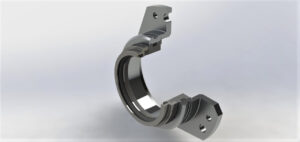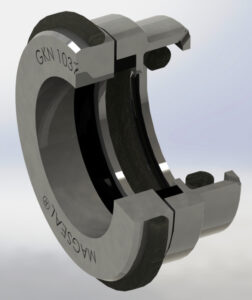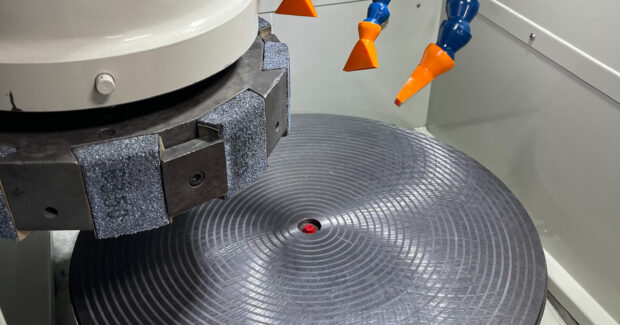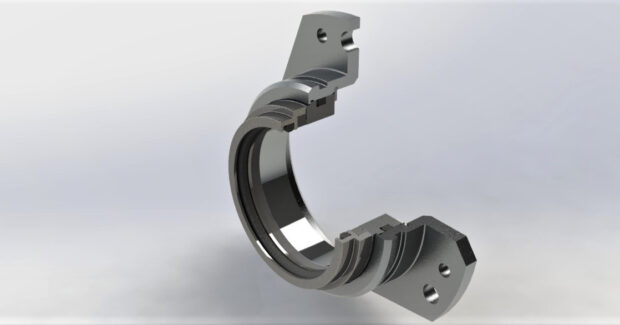Advanced Rotary Surface Grinders Speed Production of Magnetic Seals
For industrial parts subjected to high pressure and rotation, precision grinders provide the precise flatness, parallelism, and finish needed.
Posted: August 22, 2024

In manufacturing, it is often necessary to grind metal and alloy parts to very precise specifications in thickness, parallelism and surface finish. This is particularly important when the parts are subjected to extreme rotational forces and must mate face-to-face, or parallel, to other surfaces.
Rotary shaft seals are a perfect example. These crucial components seal the rotating parts of machinery, prevent lubricant leakage, and ensure impurities do not infiltrate the inner workings of engines, gearboxes and pumps. Mechanical seals, specifically, are utilized for high pressure applications demanding robust sealing capabilities. Consequently, the seal assembly components must be ground to exceptionally precise levels of flatness and parallelism to operate as effective leak-proof seals.
Unfortunately, the grinding process can be lengthy, labor intensive, and costly with conventional methods. So, when production requirements increase, manufacturers frequently turn to more advanced, automated rotary surface grinders that can achieve the precise specifications in much less time, with less operator intervention and skill.
Exceptional Seal Fit and Performance

For rotary shaft seals, various factors affect seal selection, such as shaft speed, pressure, temperature, lubricant type, and environmental conditions.
Traditional designs typically involve three main elements: a metal case that provides rigidity and structural support; a rubber sealing lip that creates a tight seal around the rotating shaft; and a spring that ensures constant pressure is maintained by the sealing lip against the shaft.
However, these seals may not perform as expected at very high pressure or rpms, where traditional seals can begin to struggle to maintain contact with the shaft (track) due to radial runout. In these cases, the spring is often unable to maintain a tight seal with the shaft.
“The seals may be rotating at 40,000 rpm and if there is an imbalance because a part was not ground to size or parallel, then it is going to throw off the whole system. The seal can become compromised, and eventually it will begin to leak,” said Jared Desrosiers, manufacturing process and technology manager, MAGSEAL, LLC, a supplier of specialty magnetic seals for critical systems that is celebrating its 70th anniversary this year.
In this type of scenario, magnetic seals create a strong attraction that eliminates the need for a spring in face seal designs.
“Magnetic seals are engineered to perform in high speed, high vibration, high altitude conditions and are excellent replacements for seals that are subjected to high torque, runout, and axial movement,” Desrosiers said.
The OEM’s magnetic seals, called MAGSEALs, provide 100% positive face-to-face sealing and are designed to operate in air, gases, water, steam, refrigerants, lubricants, fuels, and hydraulic fluids. The MAGSEALs are typically custom designed in a variety of sizes from a quarter inch to more than 6”.
Desrosiers said MAGSEALs are comprised of a magnet (stator) and a seal case (rotor). When fully assembled, the attraction force of the magnet pulls the seal case assembly into itself to create a tight seal.
The magnet is made from Cast Alnico V, a combination of aluminum, nickel, cobalt, and iron, to create the seal. The seal case is made from a ferromagnetic material, 416 or 410 stainless steel, 17-4PH for maximum corrosion protection, or 42 Alloy steel for low thermal expansion. A carbon graphite ring is installed in the seal case to complete the assembly. The carbon ring purposely protrudes out of the seal case to a specified nose height which is meant to interface with the magnet.
Each of these components — the magnet, seal case, and graphite ring — requires precise grinding to specific dimensions, parallelism and surface finish.
Although the seal case does not have to be as precise, the carbon rings that are pressed into it are ground, lapped, and polished to achieve the specified nose height. The carbon seal ring surface flatness should be within two helium light bands, 0.0000232 in. [0.000589 mm] prior to use, noted John Westgate, MAGSEAL’s manufacturing engineering technician.
For the magnet, MAGSEAL starts with a rough casting and grinds all the sides and surfaces. Secondary lapping steps are required to achieve the necessary surface finish. Currently, the OEM estimates it grinds 1,500-to-2,000 magnets each week.
In the past, the OEM utilized conventional reciprocating grinders on the magnets. Although reciprocating table grinders can be precise, the material removal rate is slow since the workpiece travels back and forth under the grinding wheel, so many grind passes are required.
However, as production requirements increased, the OEM decided to replace a slow, aging reciprocating rotary surface grinder that often needed to be repaired with advanced rotary surface grinders from Winona, Minn.-based DCM Tech.
“We were able to achieve the precision and surface finish that we were looking for with the conventional method, but it took significantly longer to grind the same number of parts,” Desrosiers said. “With the [DCM] rotary surface grinder, we knew we could achieve significant time and efficiency gains.”
Today, rotary surface grinders are designed with much more advanced sensors and controls that automatically maintain very tight tolerances, removing material down to within one ten-thousandth of an inch of the final thickness. Digital technology allows for an interface with easy-to-use touchscreen controls.
To expedite the grinding and finishing process for the magnet line, the OEM recently upgraded from a conventional rotary surface grinder to a more automated, IG 282 SD grinder from DCM Tech with a 24” variable speed table and 20hp variable speed spindle.
“We have found that nothing achieves the necessary flatness, height, and parallelism as fast as the DCM Tech rotary surface grinders,” Desrosiers said. “The required parallelism is particularly important to prevent vibration at high speeds of rotation.”
The new model includes advanced features that automate the initial contact between the abrasive wheel and the part. With this updated option, advanced sensor technology detects vibration and can automatically fine-tune not only the pressure of the spindle motor but how quickly it moves the wheel down onto the part. When the machine senses the abrasive wheel has contacted the part, it automatically begins the grind cycle.
Automatic part detection eliminates the need for the operator to do time consuming, error-prone ‘manual touch offs,’ where they would manually feed the grinding machine until it just touches the surface of the part before backing off and restarting it.
One of the reasons advanced rotary surface grinders are much faster than conventional reciprocating grinders is because the units can get much closer to the required dimensions before any finishing steps. In some cases, secondary steps can even be eliminated.
Desrosiers said the increased automation and ease of use has helped to dramatically improve magnet production. “We increased manufacturing capacity with reduced setup, loading/unloading, and cycle time,” Desrosiers said. “We decreased the cycle time by more than 300%.” By reducing or eliminating the need for subsequent finishing processes, the company was able to achieve ROI in about three months.
MAGSEAL also appreciated the rotary surface grinder’s enhanced safety and cleanliness features. Automated grinders contribute to a cleaner shop environment because the grinding is accomplished inside an enclosed shroud that contains the debris and prevents it from entering the work area. The shroud, which is a sliding door with a built-in window for viewing the process, encloses the grinding area. This has the added benefit of reducing the noise produced by the machine.
In addition to a shroud, grinders like the DCM IG series provide an integral air mist collection system that draws particulate matter from the air and moves it away from the operator to enhance the cleanliness and safety of the work environment.
“For us, safety is paramount,” Desrosiers said. “The advanced rotary surface grinder is a fully enclosed machine with door interlocks. This configuration is significantly safer and cleaner than a conventional service grinder.”
When manufacturers need high-performance components that reliably operate in the most rigorous conditions, precise grinding is often necessary to meet the exact dimensions, flat, parallel surfaces and finishes. In these cases, utilizing advanced, automated grinders that precisely and efficiently hone the component parts will help ensure that the required quality, reliability, and production goals are met.


















